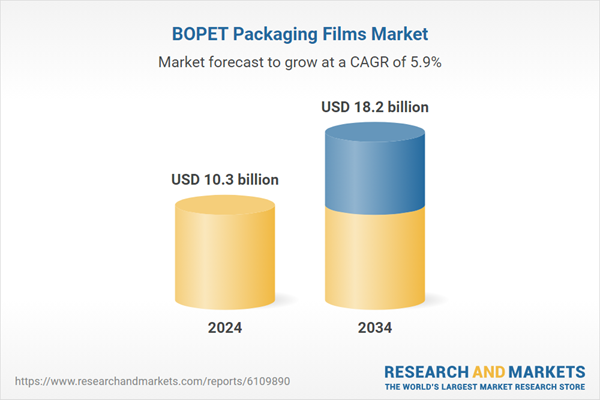Despite these headwinds, the demand for lightweight, cost-effective, and flexible packaging continues to grow. BOPET films offer a distinct advantage over rigid formats, as they are highly adaptable to different product dimensions, helping reduce volumetric weight and optimizing shipping efficiency. Consumer-driven expectations and hyperlocal delivery trends are further encouraging innovation in lightweight packaging design. The expanding global push for recyclable, tamper-evident, and extended-shelf-life packaging is also pushing the use of BOPET films across food, pharmaceuticals, electronics, and personal care industries.
The growing need for protective packaging that combines durability with flexibility continues to favor BOPET film formats over rigid alternatives. These films are especially valued for their ability to conform to various product shapes and sizes, which helps in reducing shipping volumes and, ultimately, logistics costs. This trend is in line with the increasing global demand for environmentally friendly packaging that meets both regulatory and consumer expectations.
BOPET films are also gaining popularity as ideal substrates for intelligent and active packaging technologies. In 2024, the smart packaging segment reached USD 4.8 billion. These innovative packaging solutions include functional components such as oxygen scavengers, antimicrobial agents, and moisture regulators, which interact with the internal package environment to preserve product freshness and safety. BOPET films support these applications effectively due to their high thermal stability, excellent barrier resistance, and chemical durability. These qualities make them a preferred choice for sectors such as food and beverage, healthcare, and cosmetics, where product longevity and integrity are critical.
The broader packaging application segment is forecasted to reach USD 7.3 billion by 2034. Within this space, BOPET films dominate due to their superior mechanical strength, transparency, and moisture and gas barrier capabilities. They are highly suitable for multilayer and flexible packaging systems, especially in industries demanding high performance, such as pharmaceuticals, food, and personal care. Stricter food safety laws, growing consumer awareness regarding sustainability, and the need for recyclable solutions have accelerated the use of BOPET materials in both primary and secondary packaging. Additionally, the expansion of global online retail is boosting demand for packaging that ensures product security and extends shelf life.
United States BOPET Packaging Films Market is projected to reach USD 4 billion by 2034. Demand from sectors such as federal logistics, pharmaceuticals, food, and electronics continue to drive innovation in flexible packaging. US manufacturers are under increasing pressure to shift toward recyclable and bio-based materials to align with consumer expectations and sustainability goals. These evolving demands are inspiring the development of advanced solutions such as lightweight flexible mailers and recyclable cushioning formats. Manufacturers like Mitsubishi Polyester Film GmbH worldwide are leading the charge in creating eco-friendly packaging designed for omnichannel retail models while balancing performance and sustainability.
Key players in the Global BOPET Packaging Films Market include Mitsubishi Polyester Film GmbH, SKC, SRF Limited, Polyplex, and UFlex Limited. To strengthen their market foothold, companies in the BOPET packaging films industry focus on vertical integration, investment in sustainable product development, and strategic partnerships. Leading firms are ramping up production capacities and localizing supply chains to reduce dependency on imports and mitigate tariff impacts. Innovation plays a key role, with R&D teams developing recyclable, biodegradable, and lightweight film solutions to meet shifting regulatory requirements and consumer demands. Companies are also forming alliances with e-commerce and FMCG brands to co-develop specialized packaging formats tailored for fast-moving delivery systems.
Comprehensive Market Analysis and Forecast
- Industry trends, key growth drivers, challenges, future opportunities, and regulatory landscape
- Competitive landscape with Porter’s Five Forces and PESTEL analysis
- Market size, segmentation, and regional forecasts
- In-depth company profiles, business strategies, financial insights, and SWOT analysis
This product will be delivered within 2-4 business days.
Table of Contents
Companies Mentioned
- Amcor PLC
- Avery Dennison
- BASF SE
- CCL Industries Inc.
- Checkpoint Systems, Inc
- DuPont Teijin Films
- Klöckner Pentaplast
- Sealed Air Corporation
- Sonoco Products Company
- Tetra Pak International S.A.
Table Information
| Report Attribute | Details |
|---|---|
| No. of Pages | 189 |
| Published | June 2025 |
| Forecast Period | 2024 - 2034 |
| Estimated Market Value ( USD | $ 10.3 billion |
| Forecasted Market Value ( USD | $ 18.2 billion |
| Compound Annual Growth Rate | 5.9% |
| Regions Covered | Global |
| No. of Companies Mentioned | 10 |









